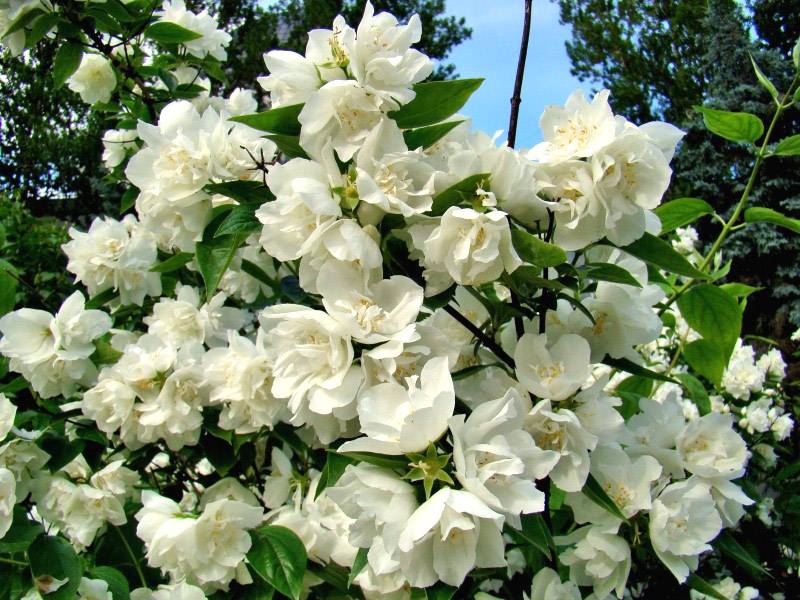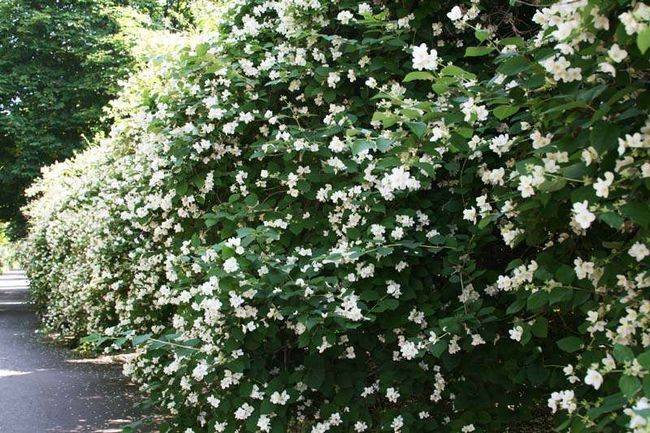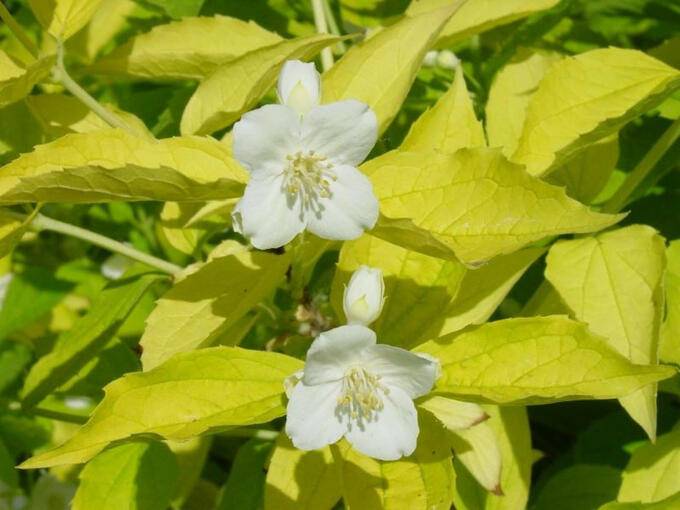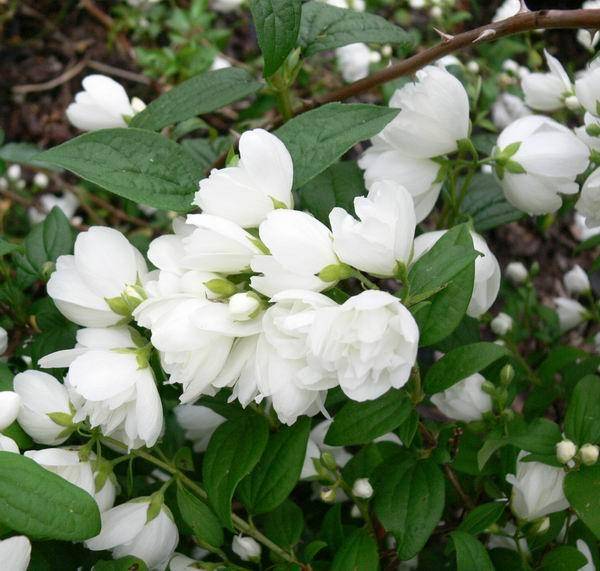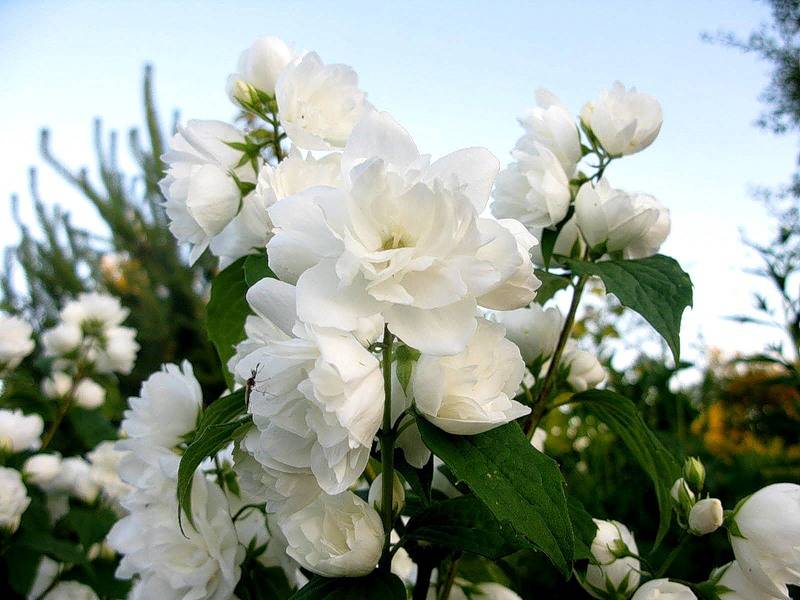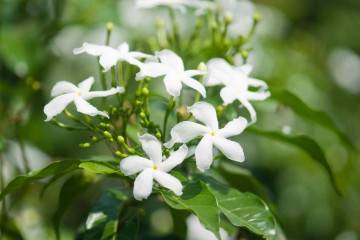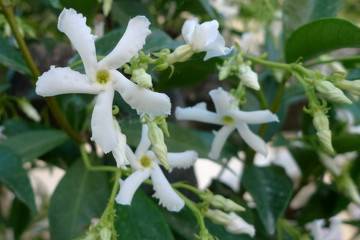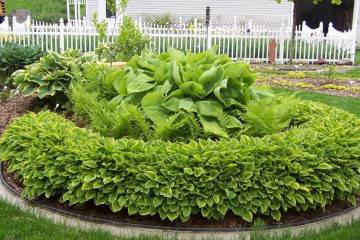Chubushnik and jasmine - what is the difference
Content:
White inflorescences, pleasant sweet aroma - what is it? Jasmine or mock orange? Why are these plants often confused, how are they different?
Jasmine or chubushnik - which usually grows in the country
Many gardeners, due to the external similarity and fragrant flowering, have combined these species under one name. In fact, chubushnik and jasmine belong to different families. Jasmine is an evergreen member of the Olive family. It is the national flower of Indonesia, the Philippines and Pakistan. Chubushnik belongs to small-leaved hydrangea shrubs. The name in Latin - "Philadelphus", which comes from the words "phileo" - "to love" and "adelphos" - "brother", is given for closely knit opposite shoots.
What is the difference between jasmine and chubushnik
Jasmine and chubushnik - what's the difference? Jasmine is a symbol of purity and simplicity, sung by ancient legends. Among the varieties there are both erect and curly specimens. Jasmine is not just an ornamental plant, its petals are used as an additive to tea, special varieties are grown for the sake of essential oils that are used in perfumery, cosmetology, aromatherapy, and medicine. Flowers for all these purposes are harvested mainly at night or in the early morning. They begin to open when the sun sets. The corolla of the flower is white or yellow, sometimes with a pink tint, a narrow long tube, inside which stamens sprout.
What is the difference between a chubushnik and garden jasmine? Chubushnik is called garden jasmine, or false. Its inflorescences are clusters of 3-9 large flowers, 2.5 to 7 cm in diameter. The main advantage is long-term abundant flowering, therefore it is widely used in landscape design. The smell in some species resembles strawberries, pineapple, and some have a faint subtle smell.
Jasmine loves warmth and grows in tropical and subtropical climates. Its historical homeland is India. In Indonesia, where they decorate weddings, it is called melati, in the Philippines - sampagita, and in Pakistan - chambeli. In South and Southeast Asia, streets are planted with it. And in Europe, the fields of Provence are famous, where the raw materials for the legendary fragrance Chanel No. 5 have been grown for more than 90 years. The Italian perfume town of Grasse also allocates territories for growing jasmines, but the cost of raw materials there is several times more expensive than in India or Morocco. Jasmine also grows in the warmest regions of Russia - in the Caucasus and Crimea. True, only two species are cultivated and also grow in the wild: yellow and real.
Chubushnik is a deciduous plant that grows in Eastern Europe, South Asia, North America.It is unpretentious, can survive on poor soils, tolerates relative shade, aridity, damp soil, but stagnant water causes rotting. It is frost-resistant, but the roots are protected by mulching for the winter. The only thing he cannot put up with is saline soil.
During flowering, the bush turns into a white cloud. The shape and color of the leaves also serve decorative purposes. Ovate-lanceolate leaves turn lemon green in autumn or retain their greenness until they fall.
There is a golden variety that is prized for its rare crown shade.
How to distinguish chubushnik from jasmine by external signs
The plants are indeed similar in appearance, but each can be identified if the differences are known. How to distinguish mock-orange and jasmine by their appearance? It is enough to compare the stems. In jasmine, they are smooth, straight or curly, and the stems of the mock-orange are covered with a thin gray-brown bark. Jasmine leaves are pinnate, that is, one plate does not have a pair, like in mountain ash, or trifoliate, located like in strawberries. The color is deep dark green. Chubushnik has green, some varieties are variegated with a white lanceolate border, in young plants - oval. The arrangement is opposite, at the same level from the stem two leaves grow opposite each other.
The difference between mock orange and jasmine is also in the aroma and shape of the flowers. In jasmine, they are of the correct shape, can be monochromatic or arranged in umbrellas, as a rule, they have five petals or double buds. The petals are fleshy, they give the oil. There is always a characteristic aroma. Inedible berries are formed in place of the buds. Chubushnik may smell like citrus, pineapple, strawberry, or have no smell at all. Inflorescences are always lush, racemose. It blooms in May-June, in warm regions it can re-bloom in the fall. As a rule, these plants are geographically located in different climatic zones, excluding some varieties.
Are there any similarities between chubushnik and jasmine
Why is one plant mistaken for another? Each is bush-shaped, but sometimes jasmines grow like vines. The similarity of some varieties during the flowering period and the aroma exuded are the reasons for the confusion. Chubushnik smells so pleasant that this property can be attributed to the gift of gods or angels, sung by ancient poets. When blooming, it seems to be covered with white foam. It grows where in the winter season the temperature drops to -25 ° С, the lower temperature limit of the southern counterpart is 10 ° С.
Types of chubushnik
The name unites more than 50 species, but only 5 species are cultivated. Common mock-mushroom reaches 3 m, blooms with loose raceme-like inflorescences, flower diameter up to 3 cm.
Lemoine - a hybrid group named after the creator V. Lemoine, includes about 40 varieties with a sweet rich aroma and buds of about 4-5 cm. Terry varieties are frost-resistant. The brightest representatives of the group:
- Bicolor. The variety has white flowers with a burgundy-pink core. The bush grows up to 2 m;
- Virginal. Terry variety associated with purity and innocence. In inflorescences, 5-7 medium buds. The bush grows up to 2 m;
- Firework. This is a bush 2.5 m in height, strewn with terry inflorescences with a delicate aroma;
- Ermine mantle. Low-growing variety with the longest flowering, up to 50 days. Hedges are planted with a mantle, well formed by pruning;
- Belle Etual. The height of the bush is up to 2 m, buds with wavy petals and a pink center. Spreading crown, low winter hardiness. The variety is suitable both for single plantings and for the formation of hedges and compositions;
- Snowbelle.A shrub of medium height, spherical in shape. It blooms with terry snow-white bells. The variety is undemanding, but does not tolerate waterlogging;
- Mont Blanc. Semi-double variety with a distinct strawberry aroma. A low-growing bush with a lot of small flowers grows.
Other equally popular varieties:
- Moonlight. A low-growing bush with dark green lush foliage, small creamy flowers and a strong strawberry scent;
- Pearl. Low, double shrub with weeping branches and large pearlescent white inflorescences;
- Shneesturm. Tall bush, up to 3 m, with arched branches and large inflorescences. Loves the sun, stretches out from lack of light. The variety has low frost resistance, in cold winters shoots freeze slightly;
- Majori. The flowers are creamy white medium-sized. Carries out temperatures up to −28 ° С;
- Minnesota Snowlake. A hybrid from the coldest state in the United States. Obtained by crossing the crown and crown. From parental bushes inherited a spreading crown, as well as lush dense double petals;
- Elbrus. The variety obtained from the crown mock-orange. He has double flowers with a complete lack of smell.
Planting a chubushnik, caring for it and reproduction
Garden jasmine, chubushnik are naturally distinguished by shade tolerance, picky about the type of soil, drought resistance. But in the shade, the branches stretch out, and scanty soils without top dressing lead to shallowness and degeneration of flowers. To achieve an amazing result, it is better to choose an open area or slight partial shade. The best option is loamy soil types, provided with humus and moisture, and for thermophilic varieties - light soil with good drainage.
The species reproduces by dividing the bush. To do this, it is dug out together with the root and divided in two, the halves are seated in prepared holes and watered. This procedure is carried out in the fall from early September to early October.
You can also propagate by layering, for this you need to follow these steps:
- Choose a young shoot of this year, which has not yet bloomed, with 2 internodes, cut along an oblique sharp knife.
- Make a straight cut 1.5 cm above the upper internode.
- Cut the leaves 2/3 with scissors.
- Prepare a container with turf soil and a 3 cm layer of sand on top.
- Make holes with a stick to a depth of about 1 cm, then insert the handle, carefully strengthening it.
- Drizzle, cover with a bottle, film or glass.
After rooting, the shelter must be removed. In warm climates, protection can be dispensed with and the cuttings can be rooted outdoors.
Shoots prepared in autumn are planted in spring.
Jasmine and mock-orange shrubs are rarely propagated by seeds. The ovaries are usually cut immediately after flowering to preserve the vigor of the plant. For the inheritance of varietal qualities, it is customary to propagate by shoots or by dividing the bush. But if the need arose, by the end of summer the ovaries will turn into dry bolls.They should be placed in a plastic bag and kept in the refrigerator. Sow in late autumn before winter, covering with straw. In spring, young seedlings are hidden from the sun using lutrasil on the frame until they get stronger.
Can be planted in a greenhouse or at home. If the soil is heavy, you need to dig a planting hole 40 × 40 cm. When planting, add two parts of compost, three - garden soil and one part of sand, a glass of ash and 1 tbsp. spoon of double superphosphate.
The care includes fertilizing, watering and pruning, the roots are insulated for the winter. Fertilize annually with one bucket of manure. Small fertilizing after flowering is possible. When planting, a young bush is immediately trimmed. Only weak shoots are cut for 1-2 buds, but already in the second year after flowering, all strong shoots are pruned to generative growths, and weak stems are removed and a crown is formed. From the third year, they carry out sanitary and shaping spring haircuts.
Chubushnik is rightfully considered one of the most beautiful garden plants in temperate climates. Easy care, splendor, amazing aroma make it a favorite of landscape designers and ordinary gardeners.
